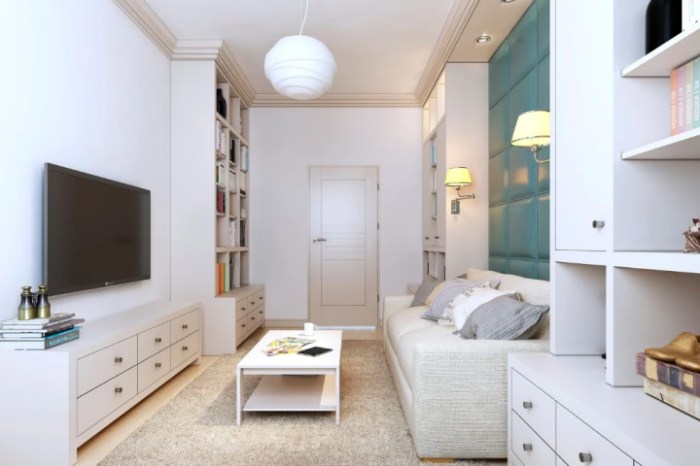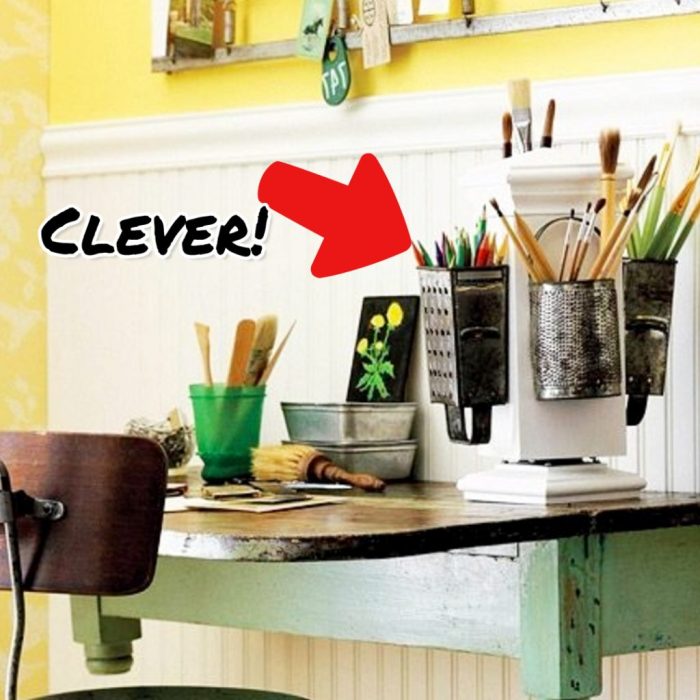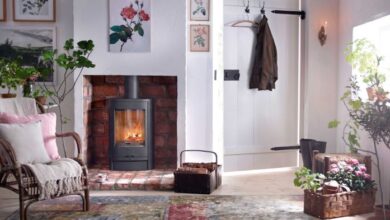Small Space Storage Solutions Maximizing Your Home
Small space storage solutions are crucial for creating functional and aesthetically pleasing living environments in compact homes. This exploration delves into innovative strategies and practical techniques to optimize storage, transforming cramped spaces into organized and comfortable havens. We’ll examine maximizing vertical space, utilizing multifunctional furniture, employing clever storage solutions, implementing decluttering strategies, and harnessing the potential of wall space.
Through detailed examples and practical advice, this guide aims to equip readers with the tools and inspiration to conquer their storage challenges and unlock the full potential of their small living spaces.
From cleverly designed shelving systems to space-saving furniture and innovative storage containers, we will cover a wide range of options tailored to different needs and preferences. Understanding the principles of minimalism and efficient organization will be key to achieving a clutter-free and harmonious home, regardless of its size. The focus will be on creating practical, visually appealing solutions that enhance both functionality and aesthetics.
Maximizing Vertical Space: Small Space Storage Solutions
In small apartments, vertical space is often the most underutilized resource. By strategically employing vertical storage solutions, you can dramatically increase your storage capacity without sacrificing valuable floor space. This approach transforms the often-ignored vertical dimensions into a functional and aesthetically pleasing part of your living area. Effective use of vertical space is key to creating a clutter-free and organized small living environment.
A Shelving System for Small Apartments
A well-designed shelving system is crucial for maximizing vertical storage. Consider incorporating shelves of varying heights and depths to accommodate different items, from books and small boxes to larger storage containers. This adaptability allows for optimal use of space and ensures items are easily accessible.
| Shelf Height (cm) | Shelf Depth (cm) | Approximate Storage Capacity | Suggested Use |
|---|---|---|---|
| 30 | 30 | Small boxes, books, decorative items | Books, collectibles, spices |
| 45 | 40 | Medium-sized storage bins, larger books | Clothing, linens, craft supplies |
| 60 | 50 | Large storage containers, bulky items | Seasonal items, blankets, luggage |
Space-Saving Furniture with Integrated Storage
Integrating storage into furniture is a clever way to maximize vertical space without cluttering the room with extra pieces. Many options exist, blending functionality with aesthetics.
- Ottomans with Hidden Compartments: These provide comfortable seating while offering hidden storage beneath the seat cushion. Ideal for storing blankets, throws, or extra pillows.
- Beds with Built-in Drawers: Under-bed storage drawers offer significant capacity for storing seasonal clothing, bedding, or other items that are not frequently used. Consider the height and accessibility of these drawers for optimal usability.
- Modular Storage Units: These customizable units allow you to adjust shelf heights and configurations to perfectly suit your needs and available vertical space. They can be easily reconfigured as your needs change.
Benefits of Vertical vs. Horizontal Storage, Small space storage solutions
Vertical storage solutions offer several advantages over their horizontal counterparts in small spaces. Vertical storage significantly increases storage capacity within the same footprint, while horizontal storage tends to consume more floor space. Utilizing vertical space keeps floors clear, creating a sense of openness and spaciousness. This is especially beneficial in smaller homes or apartments where floor space is at a premium.
Vertical storage can also enhance the visual appeal of a room, adding an element of design and sophistication. By contrast, excessive horizontal storage can often feel overwhelming and make a small space feel cramped.
Multifunctional Furniture

Source: cloudinary.com
Multifunctional furniture is a cornerstone of effective small space living. By cleverly combining the functions of several pieces into one, you can significantly reduce clutter and maximize the usable area of your home. This approach not only saves space but also contributes to a more streamlined and aesthetically pleasing environment. This section explores various multifunctional furniture options and their space-saving benefits.
Multifunctional Furniture Examples
The following table illustrates several examples of multifunctional furniture items commonly used in small spaces. Each item offers a dual or even triple purpose, allowing for efficient use of limited floor space.
| Item | Function 1 | Function 2 | Space Saving Feature |
|---|---|---|---|
| Sofa Bed | Seating | Sleeping | Converts from seating to sleeping space, eliminating the need for a separate bed. |
| Ottoman with Storage | Footrest/Seating | Storage | Provides hidden storage within the ottoman itself. |
| Storage Bed | Sleeping | Storage | Features drawers or compartments built into the bed frame. |
| Lift-Top Coffee Table | Coffee Table | Dining Table/Work Surface | The table top lifts to reveal a larger surface area, suitable for dining or working. |
| Wall-Mounted Desk | Work Surface | Storage (Shelves) | Folds away against the wall when not in use, freeing up floor space. |
Conceptual Design: Storage Sofa Bed
This design envisions a sofa bed with integrated storage. The sofa itself is a classic, mid-century modern style with a clean, streamlined silhouette. Beneath the seating cushions, a series of shallow drawers are incorporated into the frame. These drawers are accessible from the front, providing ample storage for blankets, pillows, or other items. The sofa bed mechanism is a simple, reliable design that allows for easy conversion between seating and sleeping configurations.
The overall aesthetic is minimalist and functional, suitable for a variety of interior styles. The fabric upholstery is chosen for both durability and easy cleaning, ensuring the piece remains practical and attractive for years to come. The legs are slender and tapered, maintaining a sense of lightness and preventing the piece from appearing bulky. The color palette would be neutral, such as a light gray or beige, to enhance the sense of spaciousness.
Using Furniture for Visual Separation and Storage in Studio Apartments
In studio apartments, multifunctional furniture plays a crucial role in creating distinct zones while maximizing storage. For example, a tall bookcase can be positioned to visually separate the sleeping area from the living area. The shelves provide ample storage for books, decorative items, and other belongings. Similarly, a room divider with built-in shelving units can serve as both a visual barrier and a storage solution.
A strategically placed sofa with built-in storage can define the living area while simultaneously providing a place to store extra blankets and pillows. By carefully selecting and arranging furniture, one can create a sense of separation and organization within the limited space of a studio apartment, enhancing both functionality and aesthetics.
Clever Storage Solutions
Having explored maximizing vertical space and multifunctional furniture, let’s delve into clever storage solutions that can transform even the smallest of spaces. This section will focus on innovative approaches for maximizing storage in kitchens and throughout the home, utilizing often-overlooked areas and employing efficient organizational strategies.
Effective storage is paramount in small spaces. It’s not just about
-having* storage, but about
-optimizing* it for maximum efficiency and ease of access. This section will explore several methods to achieve this.
Innovative Kitchen Storage Solutions
Small kitchens often present the biggest storage challenge. The following innovative solutions offer creative ways to maximize space and functionality.
- Pull-out pantry shelves: These maximize the often-wasted space inside deep cabinets. Advantages include improved accessibility to items at the back and better organization. A disadvantage is the added cost compared to standard shelving.
- Under-sink organizers: These tiered systems utilize the often-cluttered space under the sink. Advantages include increased storage capacity and improved hygiene by keeping cleaning supplies organized. Disadvantages might include the need for specific sink configurations and potential cost.
- Vertical spice racks: These slender racks mount to the wall, freeing up valuable counter and cabinet space. Advantages include easy access to spices and a visually appealing way to organize. A disadvantage could be limited space for larger spice containers.
- Magnetic knife strips: These free up drawer space and add a stylish element to the kitchen. Advantages include easy access to knives and a clean look. Disadvantages might include concerns about safety for children and the limited number of knives that can be stored.
- Corner cabinets with lazy susans: These maximize the often-underutilized corner space. Advantages include easy access to items in the corner and efficient use of space. Disadvantages include the added cost and potential for the lazy susan to become jammed.
Unconventional Storage Locations
Thinking outside the box is key when it comes to small space storage. Many areas often go unused, offering significant storage potential.
- Wall-mounted shelving: This creates vertical storage, freeing up floor space and adding visual interest. Shelving can be customized to fit specific needs and décor.
- Under-stair storage: This often-neglected space can be transformed into a valuable storage area with custom-built shelving or drawers.
- Above doorways: The space above doorways is frequently wasted. Shallow shelves or cabinets can be installed to store lightweight items.
- Inside hollow furniture legs: Some furniture pieces, like ottomans or coffee tables, have hollow legs that can be used for storing blankets, remotes, or other small items.
- Utilizing the back of doors: Over-the-door organizers can be used in closets or pantries to add extra storage for shoes, cleaning supplies, or other items.
Optimizing Space with Containers and Organizers
Consistent use of storage containers and organizers is crucial for efficient space utilization in closets and drawers. Standardized containers allow for stacking and maximizing vertical space, leading to a more organized and visually appealing storage solution.
Using standardized containers in closets and drawers offers several key benefits: improved organization, increased storage capacity, simplified retrieval of items, and a more visually appealing and less cluttered space.
Decluttering and Organization Strategies

Source: involvery.com
Effective decluttering and organization are paramount for maximizing space in a small bedroom. A systematic approach, focusing on efficient sorting, discarding, and storage, can transform a cramped space into a functional and calming environment. This involves not only removing unnecessary items but also strategically organizing what remains to optimize accessibility and visual appeal.
A step-by-step decluttering process for a small bedroom should begin with a thorough assessment of the space. This involves identifying areas that feel cluttered and pinpointing the sources of the clutter. Then, a systematic approach is employed to tackle the items within those areas.
A Step-by-Step Decluttering Process
Begin by dividing the bedroom into manageable zones. For instance, you might start with the closet, then move to the dresser, nightstand, and finally, the floor space. This prevents feeling overwhelmed and allows for a more focused effort. Within each zone, follow these steps:
- Empty the zone completely: Remove everything from the closet, dresser drawers, etc., creating a blank canvas. This allows for a clear view of the space and a more accurate assessment of what needs to be kept, donated, or discarded.
- Sort items into categories: Create piles for items you want to keep, donate, sell, or discard. Be decisive – if you haven’t used an item in a year, it’s likely a candidate for donation or disposal.
- Clean the area thoroughly: Once the zone is empty, take the opportunity to clean it thoroughly. Dust, vacuum, and wipe down surfaces. This creates a fresh, clean start for your reorganized space.
- Return only essential items: Carefully select the items you truly need and want to keep. Place them back in the zone in an organized manner, utilizing storage solutions discussed previously.
- Repeat for each zone: Continue this process for each zone in your bedroom until the entire room is decluttered and organized.
Categorizing Items for Storage
Categorizing items is crucial for efficient storage and retrieval in a small space. This involves grouping similar items together, making it easier to locate what you need when you need it. For example, clothing can be categorized by type (shirts, pants, dresses), season (summer, winter), and occasion (formal, casual). Books can be grouped by genre or author.
Other examples include:
- Clothing: Categorize by type (tops, bottoms, dresses), season, and occasion (work, casual, formal).
- Accessories: Group jewelry, scarves, belts, and hats in designated storage containers.
- Books: Organize by genre, author, or reading status (to-be-read, currently reading, finished).
- Documents: Use filing systems for important documents, separating them into categories like financial, medical, and personal.
Principles of Minimalist Living and Efficient Storage
Minimalist living emphasizes owning only what you need and use, actively removing excess items from your life. This philosophy directly contributes to efficient storage in small spaces by reducing the number of items that need to be stored. By embracing minimalism, you can significantly reduce clutter, simplifying your life and creating a more peaceful and organized environment. This involves conscious decision-making about purchases and regularly reviewing your possessions to identify items that no longer serve a purpose.
For example, instead of accumulating numerous pairs of shoes, a minimalist approach might involve owning only a few versatile pairs that can be worn for various occasions. Similarly, instead of having a large collection of clothes, a minimalist might choose to own a smaller, curated wardrobe of high-quality, versatile items.
Utilizing Wall Space
Wall space, often overlooked in small spaces, presents a significant opportunity for increasing storage capacity without sacrificing valuable floor area. By strategically incorporating wall-mounted storage solutions, you can maximize functionality and maintain a clutter-free environment. This section explores effective methods for utilizing wall space, focusing on practical examples and considerations for material selection.
Effective utilization of vertical wall space is key to maximizing storage in small bathrooms. A well-designed wall-mounted shelving system can significantly improve organization and accessibility of toiletries and towels. Consider the following design for a small bathroom shelving system:
Bathroom Wall-Mounted Shelving System Design
Imagine a white, L-shaped shelving unit affixed to a bathroom wall above the toilet and extending to the side. The unit measures 70cm in length (along the wall above the toilet) and 40cm in length (along the adjacent wall), with a depth of 20cm. The longest section (70cm) consists of three shelves: a top shelf (15cm high) for infrequently used items, a middle shelf (20cm high) for larger items like bath towels, and a bottom shelf (15cm high) for frequently used toiletries.
The shorter 40cm section features two shelves: a top shelf (20cm high) for folded hand towels and a bottom shelf (20cm high) for smaller toiletries and cleaning supplies. Each shelf is made of sturdy, water-resistant melamine, offering a clean and easy-to-clean surface. The unit is mounted at a height of 100cm from the floor to allow easy access while ensuring it’s out of reach of small children.
Various wall-mounted storage solutions cater to diverse needs and aesthetic preferences. The choice depends on available space, storage requirements, and overall bathroom design.
Examples of Wall-Mounted Storage Solutions
- Floating Shelves: These offer a sleek, minimalist look and are ideal for displaying decorative items or storing frequently used toiletries. They are available in various materials, sizes, and finishes to match any bathroom style. For instance, a set of three narrow floating shelves (each 60cm wide, 15cm deep, and 10cm high) can neatly hold shampoos, conditioners, and other frequently used items.
- Wall-Mounted Cabinets: These provide enclosed storage, keeping items hidden and dust-free. They are available in various sizes and configurations, from small medicine cabinets to larger units with multiple shelves and drawers. A mirrored medicine cabinet with internal shelving can efficiently store a range of toiletries while also serving as a practical mirror.
- Magnetic Strips: Perfect for smaller items like tweezers, nail clippers, or metal razors, magnetic strips provide a space-saving and visually appealing solution. A magnetic strip affixed to the inside of a cabinet door or a wall section can be a surprisingly efficient way to organize small metallic items.
The selection of materials and finishes significantly impacts the durability, aesthetics, and cost of wall-mounted storage. Consider the following:
Materials and Finishes for Wall-Mounted Storage
Material choices range from budget-friendly options to more luxurious and durable selections. The most suitable material depends on the bathroom environment, budget, and desired aesthetic.
| Material | Durability | Aesthetics | Cost | Example |
|---|---|---|---|---|
| Melamine | Good, water-resistant | Versatile, many finishes available | Low to moderate | Commonly used for shelving units |
| Wood (e.g., teak, bamboo) | Excellent, but requires sealing for moisture resistance | Natural, warm look | Moderate to high | Floating shelves or cabinets |
| Glass | Good, easy to clean | Modern, sleek look | Moderate to high | Floating shelves or cabinet doors |
| Metal (e.g., stainless steel) | Excellent, durable and water-resistant | Modern, industrial look | Moderate to high | Shelving brackets or cabinets |
Final Wrap-Up
Ultimately, mastering small space storage solutions is not just about fitting more belongings into a smaller area; it’s about creating a living space that reflects your personal style and enhances your quality of life. By strategically utilizing vertical space, selecting multifunctional furniture, and implementing clever organization techniques, you can transform a small home into a comfortable, functional, and aesthetically pleasing sanctuary.
Embracing minimalist principles and decluttering regularly will ensure your space remains organized and stress-free, allowing you to truly enjoy the benefits of living efficiently in a smaller footprint. The journey to a well-organized small space is a rewarding one, leading to a more peaceful and productive lifestyle.
Questions and Answers
What are some affordable small space storage solutions?
Over-the-door organizers, stackable storage bins, and repurposed items like jars and baskets offer budget-friendly storage solutions. DIY projects, such as building simple shelves, can also be cost-effective.
How can I prevent my small space from feeling cluttered?
Regular decluttering, using clear storage containers to maintain visibility, and sticking to a minimalist aesthetic are key to preventing a cluttered feeling. Prioritize items you use frequently and donate or discard items you no longer need.
Where can I find inspiration for small space storage ideas?
Online resources like Pinterest, home decor blogs, and websites dedicated to small space living offer a wealth of inspiration. Home improvement stores also showcase various storage solutions.
What is the best way to organize a small closet?
Utilize vertical space with shelves, hanging organizers, and drawer dividers. Fold clothes efficiently and consider vacuum-sealed storage bags for seasonal items.
How do I choose the right storage containers for my needs?
Consider the size and shape of the items you’ll be storing, the material of the containers (plastic, fabric, etc.), and whether you need clear, opaque, or labeled containers for easy identification.









